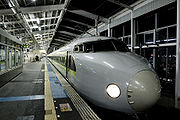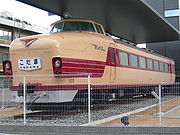.gif)
Kodama (Shinkansen)
Encyclopedia


Sanyō Shinkansen
The is a line of the Japanese Shinkansen high-speed rail network, connecting Shin-Ōsaka in Osaka with Hakata Station in Fukuoka, the two largest cities in western Japan...
.
Kodama trains stop at all stations, making Kodama the slowest Shinkansen service for trips between major cities such as Tokyo
Tokyo
, ; officially , is one of the 47 prefectures of Japan. Tokyo is the capital of Japan, the center of the Greater Tokyo Area, and the largest metropolitan area of Japan. It is the seat of the Japanese government and the Imperial Palace, and the home of the Japanese Imperial Family...
and Osaka
Osaka
is a city in the Kansai region of Japan's main island of Honshu, a designated city under the Local Autonomy Law, the capital city of Osaka Prefecture and also the biggest part of Keihanshin area, which is represented by three major cities of Japan, Kyoto, Osaka and Kobe...
. The Kodama trains are used primarily for travel to and from smaller cities such as Atami. Travelers between major cities generally take the Nozomi or Hikari services, which make fewer stops. The name of the train comes from the Japanese word kodama, meaning "echo".
Shinkansen Kodama
Kodama trains generally run over shorter distances than Nozomi and Hikari trains. Typical Kodama runs include Tokyo - Nagoya, Tokyo - Shin-Osaka, Shizuoka - Shin-Osaka, Shin-Osaka - Okayama, Shin-Osaka - Hiroshima, Okayama - Hakata and Hiroshima - Hakata, as well as some shorter late-night runs.The trainsets used for Kodama service are the same 300 series
300 Series Shinkansen
The is a Japanese high-speed Shinkansen train type introduced in 1992 on the Tōkaidō and Sanyō Shinkansen lines, initially for use on the fastest Nozomi services, being capable of...
and 700 series
700 Series Shinkansen
The is a Japanese Shinkansen high-speed train type built between 1997 and 2006, and entering service in 1999. Originally designated as "N300", they formed the next generation of shinkansen vehicles jointly designed by JR Central and JR West for use on both Tōkaidō and Sanyō Shinkansen...
trains used for the Hikari and Nozomi services. Older 100 series
100 Series Shinkansen
The is a Japanese Shinkansen high-speed train type built between 1984 and 1991 for the Tōkaidō Shinkansen and Sanyō Shinkansen high-speed lines. The earliest units have now been withdrawn from service, and the series was retired from the Tōkaidō Shinkansen line in September 2003...
trains are also used for Kodama services on the Sanyō Shinkansen. In December 2008, reconfigured 500 series
500 Series Shinkansen
The is a Shinkansen high-speed train type operated by West Japan Railway Company on the Tōkaidō Shinkansen and Sanyō Shinkansen lines in Japan. They were designed to be capable of although they currently operate at a maximum of in service...
trains entered Kodama service to replace the withdrawn Sanyō Shinkansen 0 series
0 Series Shinkansen
The trains were the first Shinkansen trainsets built to run on Japan's new Tōkaidō Shinkansen high-speed line which opened in 1964. The last remaining trainsets were withdrawn in 2008.-History:...
trains. Many Sanyō Shinkansen Kodama services continue to and from Hakata-Minami
Hakata-Minami Station
is a railway station located in Kasuga, Fukuoka, Japan. The station is operated by West Japan Railway Company .-Lines:The station is served by the Hakata-Minami Line from Hakata Station, and forms the only station on this 8.5 km line...
on the Hakata-Minami Line.
Most Kodama trains have both reserved and non-reserved cars; however, some morning Kodama trains to Tokyo and evening trains departing Tokyo have non-reserved cars only to accommodate commuters living in Kanagawa
Kanagawa Prefecture
is a prefecture located in the southern Kantō region of Japan. The capital is Yokohama. Kanagawa is part of the Greater Tokyo Area.-History:The prefecture has some archaeological sites going back to the Jōmon period...
and Shizuoka
Shizuoka Prefecture
is a prefecture of Japan located in the Chūbu region on Honshu island. The capital is the city of Shizuoka.- History :Shizuoka prefecture was formed from the former Tōtōmi, Suruga and Izu provinces.The area was the home of the first Tokugawa Shogun...
.
The newest shinkansen trainset, the N700
N700 Series Shinkansen
The is a Japanese Shinkansen high-speed train with tilting capability developed jointly by JR Central and JR West for use on the Tōkaidō and Sanyō Shinkansen lines, and also operated by JR Kyushu on the Kyushu Shinkansen line....
, is currently used on some early morning and late night Kodama runs between Kokura
Kokura Station
in Kokura Kita ward is the main railway station in Kitakyushu, Japan. It is part of the JR Kyushu network and the Sanyo Shinkansen stops here. It is the second largest station in Kyūshū with 120,000 users daily...
and Hakata
Hakata Station
Hakata Station , located in Hakata-ku, is the main railway terminal of the city of Fukuoka, Japan. It is the largest and busiest station on Kyūshū, and is a gateway to other cities in Kyūshū for travellers from Honshū. The Sanyō Shinkansen from Osaka ends at this station...
stations in Kyūshū
Kyushu
is the third largest island of Japan and most southwesterly of its four main islands. Its alternate ancient names include , , and . The historical regional name is referred to Kyushu and its surrounding islands....
. All standard-class cars are non-reserved, and, as with all other N700 services, there is no smoking on these trains except in designated on-board smoking rooms.
At most intermediate stations, Kodama trains wait for faster trains, such as the Nozomi, Hikari and Hikari Rail Star, to pass through before resuming their journeys.
N700 series (16 cars)
(All cars are no smoking except for smoking compartments located in cars 3, 7, 10, and 15.)| ←Hakata | Tokyo→ | ||||||||||||||
| 1 | 2 | 3 | 4 | 5 | 6 | 7 | 8 | 9 | 10 | 11 | 12 | 13 | 14 | 15 | 16 |
|---|---|---|---|---|---|---|---|---|---|---|---|---|---|---|---|
| NR | NR | NR | NR | NR | NR | NR | G | G | G | R | R | NR | NR | NR | R |
300/700 series (16 cars)
| ←Hakata | Tokyo→ | ||||||||||||||
| 1 | 2 | 3 | 4 | 5 | 6 | 7 | 8 | 9 | 10 | 11 | 12 | 13 | 14 | 15 | 16 |
|---|---|---|---|---|---|---|---|---|---|---|---|---|---|---|---|
| NS | NS | NS | NS | NS | NS | NS | NS | NS | S | NS | NS | NS | NS | S | S |
| NR | NR | NR | NR | NR | NR | NR | G | G | G | R | R | NR | NR | NR | R |
500 series (8 cars)
(All cars are no smoking except for smoking compartments in cars 3 and 7.)| ←Hakata | Shin-Osaka→ | ||||||
| 1 | 2 | 3 | 4 | 5 | 6 | 7 | 8 |
|---|---|---|---|---|---|---|---|
| NR | NR | NR | NR | NR | R | NR | NR |
N700 series (8 cars)
(All cars are no smoking except for smoking compartments in cars 3 and 7.)| ←Hakata | Shin-Osaka→ | |||||||
| 1 | 2 | 3 | 4 | 5 | 6 | 7 | 8 | |
|---|---|---|---|---|---|---|---|---|
| NR | NR | NR | NR | R | R | G | NR | NR |
700 series (8 cars)
| ←Hakata | Shin-Osaka→ | ||||||
| 1 | 2 | 3 | 4 | 5 | 6 | 7 | 8 |
|---|---|---|---|---|---|---|---|
| NS | NS | NS | NS | NS | S | NS | NS |
| NR | NR | NR | NR | NR | NR | NR | C |
100 series (6 cars)
| ←Hakata | Shin-Osaka→ | ||||
| 1 | 2 | 3 | 4 | 5 | 6 |
|---|---|---|---|---|---|
| S | NS | NS | NS | NS | S |
| NR | NR | NR | R | NR | NR |
- G: Green car (first class) (reserved seating)
- R: Standard class reserved seating
- C: Standard class reserved seating + compartments
- NR: Standard class non-reserved seating
- NS: Non-smoking seats
- S: Smoking seats
Pre-Shinkansen Kodama

Limited express
A limited express is a type of express train service. It refers to an express service that stops at a limited number of stops in comparison to other express services on the same or similar routes.- Japan :...
service on the Tōkaidō Main Line on November 1, 1958. Services used 151 series trainsets. This was the first EMU
Electric multiple unit
An electric multiple unit or EMU is a multiple unit train consisting of self-propelled carriages, using electricity as the motive power. An EMU requires no separate locomotive, as electric traction motors are incorporated within one or a number of the carriages...
train service of the Japanese National Railways
Japanese National Railways
, abbreviated or "JNR", was the national railway network of Japan from 1949 to 1987.-History:The term Kokuyū Tetsudō "state-owned railway" originally referred to a network of railway lines operated by nationalized companies under the control of the Railway Institute following the nationalization...
classified as a limited express, the highest (fastest) of train types on the national railway system. The train travelled between Tokyo Station
Tokyo Station
is a train station located in the Marunouchi business district of Chiyoda, Tokyo, Japan, near the Imperial Palace grounds and the Ginza commercial district....
and Ōsaka Station
Osaka Station
is a station on the West Japan Railway Company located in the Umeda district in Kita-ku, Osaka, Japan. It is the city's main rail terminal in the north....
in 6 hours and 50 minutes and first enabled passengers to go and return between the two cities in one day. This is why the train was named Kodama, or echo.
A narrow gauge
Narrow gauge
A narrow gauge railway is a railway that has a track gauge narrower than the of standard gauge railways. Most existing narrow gauge railways have gauges of between and .- Overview :...
world speed record of 163 km/h was established by a 151 series Kodama trainset on July 31, 1959. The conventional Kodama train ran until September 30, 1964, the day before Kodama debuted on the Shinkansen.

